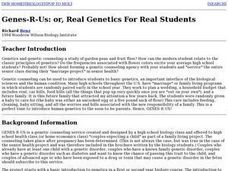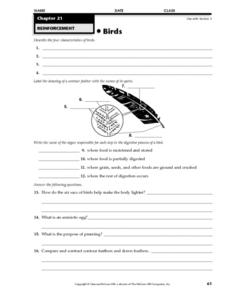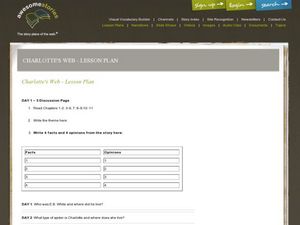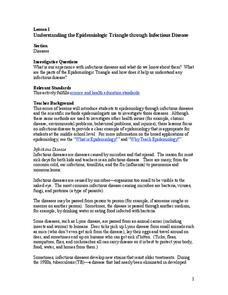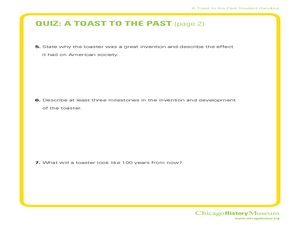Curated OER
Self-Assessment
Young scholars take a personal inventory about behaviors. They determine if there are risky behaviors present that could be harmful. The inventory is used to help students examine how to make healthy decisions.
Curated OER
African Markets: Out in the Open
Students identify advantages and disadvantages of African open air markets. They discuss the types of items sold there and why the markets are outdoors. They observe a bartering session between the teacher and another adult. Finally,...
Curated OER
Life Cycle Literature Briefs
Literature containing life cycle information is available from many sources. Several examples of this type of literature are listed below with a synopsis and sample questions for each. These examples have been taken from a variety of...
Curated OER
Genes-R-Us: or, Real Genetics For Real Students
Students explore genetics and genetic counseling. They research information on human genetic disorders. Students simulate developing a complete counseling service to assist the community.
Curated OER
Using A Winogradsky Column to Analyze Microbial Communities
Students use easily obtained materials to study ecological succession in a microbiological community. This investigation is appropriate for a variety of age groups. Elementary Students be fascinated by the changes occurring over time...
Curated OER
Is Dilution the Solution To Pollution?
Students demonstrate the meaning of dilution and concentration and how pollution can affect the water that you drink. They perform an experiment to calculate the final concentration and dilution factor of solutions. They record the color...
Curated OER
Ant City
Students develop an ant colony that adults and children can visit. Students create different areas including places where tourists can view live ants, play ant games, research facts about ants, and create ant art. Students serve as...
Curated OER
Mystery Recipe Lab
Students engage in a lesson that is concerned with the concept of cooking a new recipe. The book "Cook-a-Doodle-Doo" is used to create the context for the lesson. They use the ingredients and recipe in the lesson and work in groups in...
Curated OER
Butterfly Life Cycle
Students identify the stages in the butterfly life cycle. After completing a KWL chart, students participate in a brief lecture on the stages of the butterfly life cycle. Using reading books and Internet research, students complete an...
Curated OER
What Makes A Bird A Bird?
Young scholars identify the characteristics of birds and explain how these characteristics are useful in their survival. They explain how both physical and environmental adaptations help birds survive and reproduce. Students create an...
Curated OER
Bird Activity
In this bird worksheet, students complete a set of 16 activities about birds, listing characteristics, matching organs with steps in the digestive process, labeling a drawing of a feather and completing 4 short answer questions.
Curated OER
Ferns and Gymnosperms
In this fern and gymnosperm worksheet, students will read about two types of vascular tissue: xylem and phloem. Then students will read about the difference between sporophytes and gametophytes. Using this information students will...
Curated OER
Genetic Technology
For this genetic technology worksheet, students will answer 6 true or false statements and 4 short answer questions based on the mapping and sequencing of the human genome and the applications of the Human Genome Project.
Curated OER
Fishes
In this fish worksheet, students will review the characteristics of fish by comparing the jaws, skeleton, and fertilization of each fish class. Then students will use a phylogenetic tree to compare the groups of fish to ancestral...
Curated OER
Segmented Worms
In this segmented worms worksheet, high schoolers will review the characteristics of segmented worms including the earthworm, bristleworm, and leech. This worksheet has 7 fill in the blank, 3 true or false, and 3 matching questions.
Curated OER
General Knowledge Quiz
In this general knowledge worksheet, students attempt to answer 30 trivia questions on subjects ranging from art, geography, films, books and popular culture. The directions say to listen and answer. It is unclear how this is to be used;...
Curated OER
Birds
In this birds instructional activity, students review the characteristics of birds including their adaptations for flight. Students review the diversity of bird adaptations. This instructional activity has 4 short answer, 7 true or...
Curated OER
Seasonal Customs Worksheet
In this seasonal customs worksheet, students identify, sort, and brainstorm customs associated with certain seasons of the year.
Curated OER
Cells Vocabulary Quiz
In this cells vocabulary worksheet, students draw lines to match 12 words pertaining to cells to their meanings. Prior knowledge is assumed.
Curated OER
Charlotte's Web Comprehension
In this Charlotte's Web story comprehension worksheet, students find the theme, answer comprehension questions, write details about characters and events, and write a short essay on the book Charlotte's Web.
Curated OER
Understanding the Epidemiologic Triangle through Infectious Disease
Students examine the epidemiologic triangle. In this disease lesson, students discuss infectious disease as they study how they spread and discover their families' experiences with them. Students research Internet sites to complete...
Curated OER
Why is Rice Good for Us?
Third graders explore why rice is good for our bodies. In this nourishment lesson, 3rd graders review the food pyramid and discuss serving sizes. Students discuss the different ways rice is used in food. Students use uncooked rice to...
Curated OER
A Toast To The Past
Young scholars analyze, and research the identity of the non electric toaster as a historical artifact. In this toaster lesson plan, students then create a visual timeline of toaster history.
Curated OER
North American Butterflies and Moths of Fields, Meadows, and Fencerows
In this North American butterflies and moths worksheet, students click on the links in the questions about North American butterflies and moths of fields, meadows, and fencerows to find the answers to the questions and then come back and...



